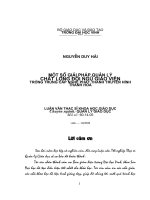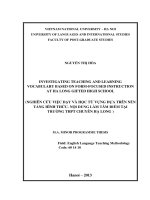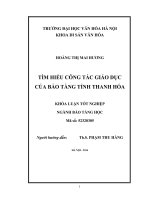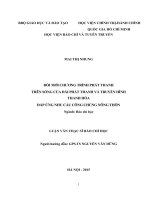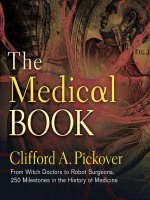Nền tảng hình thành Hóa Dược Ebook Full English
Bạn đang xem bản rút gọn của tài liệu. Xem và tải ngay bản đầy đủ của tài liệu tại đây (26.89 MB, 549 trang )
BooksbyCliffordA.Pickover
TheAlienIQTest
ArchimedestoHawking
ABeginner’sGuidetoImmortality
BlackHoles:ATraveler’sGuide
CalculusandPizza
ChaosandFractals
ChaosinWonderland
Computers,Pattern,Chaos,andBeauty
ComputersandtheImagination
Cryptorunes:CodesandSecretWriting
DreamingtheFuture
EggDropSoup
FractalHorizons:TheFutureUseofFractals
FrontiersofScientificVisualization
FutureHealth
TheGirlWhoGaveBirthtoRabbits
TheHeavenVirus
JewsinHyperspace
KeystoInfinity
LiquidEarth
TheLobotomyClub
TheLoomofGod
TheMathBook
TheMathematicsofOz
MazesfortheMind:Computersandthe
Unexpected
Mind-BendingVisualPuzzles(calendarsandcardsets)
TheMöbiusStrip
TheParadoxofGodandtheScienceof
Omniscience
APassionforMathematics
ThePatternBook:Fractals,Art,andNature
ThePhysicsBook
TheScienceofAliens
Sex,Drugs,Einstein,andElves
SpiderLegs(withPiersAnthony)
SpiralSymmetry(withIstvanHargittai)
TheStarsofHeaven
StrangeBrainsandGenius
SushiNeverSleeps
SurfingthroughHyperspace
Time:ATraveler’sGuide
VisionsoftheFuture
VisualizingBiologicalInformation
WondersofNumbers
TheZenofMagicSquares,Circles,andStars
THE
MEDICAL
BOOK
FROMWITCHDOCTORSTOROBOTSURGEONS,250MILESTONESIN
THEHISTORYOFMEDICINE
CliffordA.Pickover
AuthorofTheMathBookandThePhysicsBook
STERLINGandthedistinctiveSterlinglogoareregisteredtrademarksofSterlingPublishingCo.,Inc.
©2012byCliffordA.Pickover
Allrightsreserved.Nopartofthispublicationmaybereproduced,storedinaretrievalsystem,ortransmitted,inany
formorbyanymeans,electronic,mechanical,photocopying,recording,orotherwise,withoutpriorwrittenpermission
fromthepublisher.
ISBN978-1-4027-8585-6(hardcover)
ISBN978-1-4027-9233-5(ebook)
LibraryofCongressCataloging-in-PublicationData
Pickover,CliffordA.
Themedicalbook:fromwitchdoctorstorobotsurgeons:250milestonesinthehistory
ofmedicine/CliffordA.Pickover.
p.;cm.
Fromwitchdoctorstorobotsurgeons:250milestonesinthehistoryofmedicine
ISBN978-1-4027-8585-6(hardcover)—ISBN978-1-4027-9233-5(ebook)
I.Title.II.Title:Fromwitchdoctorstorobotsurgeons:250milestonesinthehistoryof
medicine.
[DNLM:1.HistoryofMedicine—Chronology.WZ30]
610.9—dc23
2011050376
Forinformationaboutcustomeditions,specialsales,andpremiumandcorporate
purchases,pleasecontactSterlingSpecialSalesat800-805-5489or
24681097531
www.sterlingpublishing.com
“Trulythegodshavenotfromthebeginningrevealedallthingsto
mortals,butbylongseeking,mortalsmakeprogressindiscovery.”
—XenophanesofColophon,c.500B.C.
“Wherevertheartofmedicineisloved,therealsoisloveofhumanity.”
—Hippocrates,c.400B.C.
Contents
Introduction
10,000B.C.WitchDoctor
6500B.C.Trepanation
4000B.C.Urinalysis
3000B.C.Sutures
2800B.C.GlassEye
2400B.C.Circumcision
2000B.C.AyurvedicMedicine
1600B.C.EdwinSmithSurgicalPapyrus
1500B.C.Bloodletting
1000B.C.GrevilleChesterGreatToe
600B.C.EyeSurgery
600B.C.SewageSystems
400B.C.HippocraticOath
300B.C.HuangdiNeijing
100B.C.MithridatiumandTheriac
70Abortion
70Dioscorides’sDeMateriaMedica
190GalenicWritings
900Al-Razi’sComprehensiveBook
1025Avicenna’sCanonofMedicine
1161PersecutionofJewishPhysicians
1210BarberPole
1242Al-Nafis’sPulmonaryCirculation
1284Eyeglasses
1346BiologicalWeapons
1510Leonardo’sAnatomicalDrawings
1522BurningofDr.Wertt
1527ParacelsusBurnsMedicalBooks
1543DeHumaniCorporisFabrica
1545Paré’s“RationalSurgery”
1552Eustachi’sRescuedMasterpieces
1563DePraestigiisDaemonum
1564Condom
1580ObstetricalForceps
1597TissueGrafting
1601AcupunctureCompendium
1618DrawingsofPietrodaCortona
1628CirculatorySystem
1642MurderandWirsung’sDuct
1652LymphaticSystem
1664CranialNervesClassified
1665Micrographia
1678DiscoveryofSperm
1679Brunner’sGlands
1683ZooWithinUs
1687DiscoveryofSarcoptesScabiei
1689SeparationofConjoinedTwins
1707PulseWatch
1726MaryToft’sRabbits
1733Cheselden’sOsteographia
1747Albinus’sTablesoftheHumanBody
1753ATreatiseonScurvy
1761Autopsy
1761CausesofCancer
1761Morgagni’s“CriesofSufferingOrgans”
1764CerebrospinalFluid
1772ExploringtheLabyrinth
1774Hunter’sGravidUterus
1784Hospitals
1784Lavoisier’sRespiration
1785Digitalis
1792Ambulance
1793UnchainingtheLunatics
1796AlternativeMedicine
1796Phrenology
1798SmallpoxVaccination
1809CerebellumFunction
1811Bell-MagendieLaw
1812SnowAnesthesia
1812WomenMedicalStudents
1813Hysterectomy
1816Stethoscope
1817LigationoftheAbdominalAorta
1825LeechTherapy
1829BloodTransfusion
1830MedicalSpecialization
1832AnatomyActof1832
1832IntravenousSalineSolutions
1833ObservationsofSt.Martin’sStomach
1842GeneralAnesthesia
1842TheSanitaryConditionoftheLabouringPopulationofGreatBritain
1846Panum’s“MeaslesontheFaroeIslands”
1846Spirometry
1847AmericanMedicalAssociation
1847Semmelweis’sHandWashing
1848Appendectomy
1850Ophthalmoscope
1851PlasterofParisCasts
1853HypodermicSyringe
1854BroadStreetPumpHandle
1854Nursing
1855CellDivision
1857TreatmentofEpilepsy
1858Gray’sAnatomy
1861CerebralLocalization
1862GermTheoryofDisease
1863RedCross
1864DentalDrill
1865Antiseptics
1865Mendel’sGenetics
1866MedicalThermometer
1872ThyroidSurgery
1873CauseofLeprosy
1879ModernBrainSurgery
1881Sphygmomanometer
1882CesareanSection
1882Koch’sTuberculosisLecture
1882PhagocytosisTheory
1883HealthInsurance
1883Salpingectomy
1884CocaineasLocalAnesthetic
1890Antitoxins
1890LatexSurgicalGloves
1891NeuronDoctrine
1892DiscoveryofViruses
1892Osteopathy
1893DiscoveryofAdrenaline
1894CauseofBubonicPlague
1895D.D.PalmerandChiropractic
1895X-rays
1897CauseofMalaria
1899Aspirin
1899Defibrillator
1899HearingAids
1899Psychoanalysis
1902Caduceus
1902ChromosomalTheoryofInheritance
1902InbornErrorsofMetabolism
1902CauseofSleepingSickness
1902VascularSuturing
1903Electrocardiograph
1903RadiationTherapy
1904HalstedianSurgery
1905CornealTransplant
1905GenesandSexDetermination
1906“Analytic”VitaminDiscovery
1906Allergies
1906Alzheimer’sDisease
1906MeatInspectionActof
1906PatentMedicines
1906CauseofRockyMountainSpottedFever
1907ImprisonmentofTyphoidMary
1907SearchesfortheSoul
1910ChlorinationofWater
1910Ehrlich’sMagicBullets
1910FlexnerReportandMedicalEducation
1914CommonCold
1914FluoridatedToothpaste
1914Neurotransmitters
1916Heparin
1920Band-AidBandage
1921HumanGrowthHormone
1922BanishingRickets
1922CommercializationofInsulin
1922TruthSerum
1924HumanElectroencephalogram
1925ModernMidwifery
1926LiverTherapy
1927SterilizationofCarrieBuck
1928“TheRabbitDied”
1928IronLung
1928PapSmearTest
1928Penicillin
1929IUD
1929MaggotTherapy
1929MedicalSelf-Experimentation
1933Jung’sAnalyticalPsychology
1935Stanley’sCrystalInvaders
1935SulfaDrugs
1937Antihistamines
1937CauseofYellowFever
1938ElectroconvulsiveTherapy
1943“AutisticDisturbances”
1943Dialysis
1944Blalock-TaussigShunt
1946CancerChemotherapy
1946TransorbitalLobotomy
1947InformedConsent
1947Prosopagnosia
1948Cortisone
1948NerveGrowthFactor
1948RandomizedControlledTrials
1949CauseofSickle-CellAnemia
1949Mammography
1950Antipsychotics
1951HeLaCells
1951TobaccoSmokingandCancer
1952Amniocentesis
1952ArtificialHeartValves
1953DNAStructure
1953Heart-LungMachine
1954Endoscope
1954KidneyTransplant
1955Birth-ControlPill
1955PlaceboEffect
1955PolioVaccine
1956AutoimmuneDiseases
1956BoneMarrowTransplant
1956CardiopulmonaryResuscitation
1957LevodopaforParkinson’sDisease
1957FetalMonitoring
1957MedicalUltrasound
1958ArtificialPacemakerforHeart
1958HipReplacement
1958PinealBody
1959Nanomedicine
1959Radioimmunoassay
1959StructureofAntibodies
1960Laser
1961Self-Surgery
1961Thymus
1962Cryonics
1962MitochondrialDiseases
1962ThalidomideDisaster
1963CognitiveBehavioralTherapy
1963LiverTransplant
1963LungTransplant
1964Angioplasty
1964Beta-Blockers
1964HandTransplant
1966PancreasTransplant
1967CATScans
1967HeartTransplant
1967Hospice
1970ReverseTranscriptaseandAIDS
1972Cyclosporine
1973PositronEmissionTomography(PET)
1973Statins
1975Near-DeathExperiences
1976Oncogenes
1977CochlearImplants
1977MagneticResonanceImaging(MRI)
1978FirstTest-TubeBaby
1981FetalSurgery
1981LaparoscopicSurgery
1982Prions
1983Epigenetics
1983PolymeraseChainReaction
1984PepticUlcersandBacteria
1984Telomerase
1987SmallBowelTransplant
1990GeneTherapy
1991DoNotResuscitate
1998RNAInterference
2000RoboticSurgery
2001Telesurgery
2003HumanGenomeProject
2005FaceTransplant
2006GrowingNewOrgans
2008HumanCloning
NotesandFurtherReading
Index
PhotoCredits
AbouttheAuthor
Introduction
TheScopeofMedicine
WelcometoTheMedicalBook,avastjourneyintothehistoryofmedicinethatincludes
eminently practical topics along with the odd and perplexing. We’ll encounter subjects
that range from circumcision to near-death experiences and from witch doctors to robot
surgeons. Educational content from The Great Courses provides a wonderful glimpse of
therichnessofmedicalhistoryandtheamazingprogresshumankindhasmadefromthe
StoneAgeuntiltoday:
Intoday’seraofmodernWesternmedicine,organtransplantsareroutine,anddailyheadlinesaboutthemysteriesof
DNAandthehumangenomepromisethatthesecretsoflifeitselfaretantalizinglywithinourreach.…Yettoreach
thispointtookthousandsofyears.Onestepatatime…humanity’smedicalknowledgehasmovedforwardfroma
timewheneventheslightestcutheldthethreatofinfectionanddeath,whentheflowofbloodwithinthebodywas
a mystery, and “cells” were not even a concept, and when the appearance of a simple instrument allowing a
physiciantolistentothebeatofadiseasedheartwasaprofoundadvance.
EachentryinTheMedicalBookisshort—atmostonlyafewparagraphs.Thisformat
allows readers to jump in and ponder a subject without having to sort through a lot of
verbiage.Whenwasthefirsttimephysiciansstudiedmaggottherapytocleanwoundsand
savelives?Turntotheentry“MaggotTherapy”forabriefintroduction.Doacupuncture
and truth serum really work? When was the first eye surgery performed? Will humans
everbeabletobefrozenandresurrectedacenturylater?What’sthedifferencebetween
yellowfeverandsleepingsickness?We’lltackletheseandotherthought-provokingtopics
inthepagesthatfollow.Healthcareisamongthemostsignificantissuesofourtime,and
it will be more so in the future. This book should appeal to students and their parents,
health-carepractitioners,andevenmanyoftheexuberantfansofGrey’sAnatomy,House
M.D.,andthecountlessmedicalshows—past,present,andfuture—thatcaptureourhearts
andminds.
WhencolleaguesaskmewhatIfeelarethegreatestmilestonesinmedicine,Iusually
offerthreeevents.Thefirstinvolvestheuseofligaturestostemtheflowofbloodduring
surgeries,forexample,asperformedbytheFrenchsurgeonAmbroiseParé(1510–1590).
He promoted the ligature (e.g., tying off with twine) of blood vessels to prevent
hemorrhage during amputations, instead of the traditional method of burning the stump
with a hot iron to stop bleeding. The second key milestone includes methods for
decreasingpainthroughgeneralanestheticssuchasether,attributedtoseveralAmerican
physicians. The third breakthrough concerns antiseptic surgery, which was promoted by
British surgeon Joseph Lister (1827–1912), whose use of carbolic acid (now called
phenol) as a means of sterilizing wounds and surgical instruments dramatically reduced
postoperativeinfections.
Ifpressed,Iwouldaddtwoadditionalkeydevelopmentsinthehistoryofmedicine.The
useofX-rayswasthefirstofseveralgroundbreakingmodernapproachesforvisualizing
theinterioroflivinghumans.Alsoveryimportantwasthegraduallyincreasingopenness
of physicians and authorities to the dissection of bodies in order to learn about human
anatomy. In fact, several milestones in this book offer portrayals of the human body by
such greats as Leonardo da Vinci (1452–1519), Bartolomeo Eustachi (1500–1574),
Andreas Vesalius (1514–1564), Pietro da Cortona (1596–1669), William Cheselden
(1688–1752),BernhardSiegfriedAlbinus(1697–1770),WilliamHunter(1718–1783),and
Henry Gray (1827–1861). In order to become seasoned dissectors and anatomists,
surgeons of the past often were able to suppress normal emotional responses for their
human brethren. For example, English physician William Harvey (1578–1657), famous
forhiselucidationofbloodcirculation,participatedindissectionsofbothhissisterandhis
father.Intheearly1800s,theappetiteforcorpseswassogreatinEnglandthatanatomists
frequentlycollaboratedwithgraverobberstosecureneededspecimens.AsImentionlater
inthisbook,arthistoriansMartinKempandMarinaWallacewrite,“Theportrayalofthe
human body, however ostensibly neutral or technical the illustration, always involves a
series of choices, and invariably brings into play strong sensations. Historical images of
thedissectedbodyrangefromthemostflamboyantofthemulticoloredwaxes,inwhich
dissectedfiguresassumetherolesofexpressiveactorsandactressesintheirowntimeless
drama, to the remorselessly sober woodcuts in Henry Gray’s famous Anatomy. All the
imagesexhibitwhatanarthistorianwouldcall‘style.’”
Historian Andrew Cunningham writes, “The problem underlying all illustrations of
anatomical dissection is that they are all … idealizations. Indeed this is why engravings
[andphotographs]areattemptsatsolvingthesameproblem:thatofbringingintoview…
thethingsthattheanatomistwishestomakevisible.Foranatomizingisnotonlyavery
messy business … but distinguishing all the structures that are visible to the eye of the
trainedanatomistisverydifficultforthosewhoarenotyetanatomists.”
On a personal note, I should mention that I’ve suffered from a strange case of
anatophilia—thatis,anextremeloveofanatomy—sincechildhood.WhileIwasgrowing
up in New Jersey, my bedroom featured plastic anatomical models of the heart, brain,
head, eye, and ear. My walls were covered with posters of organ systems rendered in
exquisiteprecision.Incollege,IworeonlyanatomyT-shirtsfeaturingcirculatorysystems,
dissected frogs, and the like. It is this passion for understanding biology and the human
bodythatledmetowritethisbook.
Finally, we should note that before germ theory and the rise of modern science, a
significantportionofmedicinewasbasedonsuperstitionandtheplaceboeffect.Onthis
topic, medical experts Arthur and Elaine Shapiro write, “For example, the first three
editionsoftheLondonPharmacopoeiapublishedintheseventeenthcenturyincludedsuch
uselessdrugsasusnea(mossfromtheskullofvictimsofviolentdeath)andVigo’splaster
([including]viper’sflesh,livefrogs,andworms).”EventhebeloveddoctorIraJohnsonin
RobertHeinlein’snovelToSailBeyondtheSunsetadmitsthelimitationsofmedicineand
theubiquityoftheplaceboeffectinruralAmericaaround1900:“Idon’tdothemmuch
good.Iodine,calomel,andAspirin—that’saboutallwehavetodaythatisn’tasugarpill.
TheonlytimesI’mcertainofresultsarewhenIdeliverababyorsetaboneorcutoffa
leg.”Eventoday,accordingtotheInstituteofMedicine,lessthanhalfthesurgeries,drugs,
andteststhatdoctorsrecommendhavebeenprovedeffective.
PurposeandChronology
MygoalinwritingTheMedicalBookistoprovideawideaudiencewithabriefguideto
importantmedicalmilestones,ideas,andthinkers,withentriesshortenoughtodigestina
fewminutes.Manyentriesareonesthatinterestmepersonally.Alas,notallofthegreat
medicalmilestonesareincludedinthisbook,inordertopreventthebookfromgrowing
toolarge.Thus,incelebratingthewondersofmedicineinthisshortvolume,Ihavebeen
forced to omit many important medical marvels. Nevertheless, I believe that I have
included a majority of those with historical significance and that have had a strong
influenceonmedicine,society,orhumanthought.In1921,BritishneurosurgeonCharles
Ballancedeliveredatalktitled“AGlimpseintotheHistoryofSurgeryoftheBrain,”in
which he said that the history of brain surgery was so vast that he would not make an
efforttotouchuponallofit,butwouldmerely,“likeanalpinetraveler,saluteafewofthe
peaks and pass on.” We will do the same for these medical milestones. Sometimes,
snippetsofinformationarerepeatedsothateachentrycanbereadonitsown.Occasional
textinaboldfontpointsthereadertorelatedentries.Forexample,sleepingsicknessmay
appearinboldbecauseithastheindexitemSleepingsickness,cause.Additionally,asmall
SEEALSOsectionnearthebottomofeachentryhelpsweaveentriestogetherinawebof
interconnectedness and may help the reader traverse the book in a playful quest for
discovery.
TheMedicalBookreflectsmyownintellectualshortcomings,andwhileItrytostudyas
manyareasofmedicalhistoryasIcan,itisdifficulttobecomefluentinallaspects;this
book clearly reflects my own personal interests, strengths, and weaknesses. I am
responsibleforthechoiceofpivotalentriesincludedinthisbookand,ofcourse,forany
errorsandinfelicities.Thisisnotacomprehensiveorscholarlydissertation,butratheris
intended as recreational reading for students of science and interested laypersons. I
welcome feedback and suggestions for improvement from readers, as I consider this an
ongoingprojectandalaboroflove.
Thisbookisorganizedchronologically,accordingtotheyearassociatedwithanentry.
Many of the older dates in this book, including the B.C. dates, are only approximate.
Ratherthanplacethetermcircainfrontofalloftheseolderdates,whichdesignatesan
approximatedate,Iinformthereaderherethattheancientdatesareonlyroughestimates.
Formostentries,Iuseddatesthatareassociatedwithadiscoveryorbreakthrough.Of
course, dating of entries can be a question of judgment when more than one individual
made a contribution. Often, I have used the earliest date associated with a discovery or
event,butsometimes,afterhavingsurveyedcolleaguesandotherscientists,Idecidedto
usethedatewhenaconceptgainedparticularprominence.
ThefamousCanadianphysicianWilliamOsleroncewrote,“Inscience,thecreditgoes
tothemanwhoconvincestheworld,nottothemantowhomtheideafirstoccurs.”When
weexaminediscoveriesinmedicine,inhindsightweoftenfindthatifonescientistdidnot
make a particular discovery, some other individual would have done so within a few
monthsoryears.Mostscientists,asNewtonsaid,stoodontheshouldersofgiantstosee
justabitfartheralongthehorizon.Often,morethanoneindividualcreatesessentiallythe
samedeviceorunravelsthesamemedicalmysteryataboutthesametime,butforvarious
reasons—includingsheerluck—historyremembersonlythemorefamousdiscovererand
completely forgets the others. Perhaps the time was ripe for such discoveries, given
humanity’s accumulated knowledge at the time the discoveries were made. We may be
reluctanttobelievethatgreatdiscoveriesarepartofa“discoverykaleidoscope”mirrored
innumerousindividualsatonce.However,thehistoryofscienceisrepletewithexamples.
AlexanderGrahamBellandElishaGray,workingindependently,filedtheirownpatents
on telephone technologies on the same day. As sociologist of science Robert Merton
remarked,“Thegeniusisnotauniquesourceofinsight;heismerelyanefficientsourceof
insight.
Mertonalsosuggestedthat“allscientificdiscoveriesareinprinciple‘multiples’”—that
is,thesamediscoveryisoftenmadebymorethanoneperson.Sometimesadiscoveryis
namedafterthepersonwhodevelopsthediscoveryratherthantheoriginaldiscoverer.The
greatanatomistWilliamHunterfrequentlyquarreledwithhisbrotheraboutwhowasfirst
in making a discovery, but even Hunter admitted, “If a man has not such a degree of
enthusiasm and love of the art, as will make him impatient of unreasonable opposition,
and of encroachment upon his discoveries and his reputation, he will hardly become
considerableinanatomy,orinanyotherbranchofnaturalknowledge.”WhenMarkTwain
was asked to explain why so many inventions were invented independently, he said,
“Whenit’ssteamboattime,yousteam.”
Readersmaynoticethatasignificantnumberofdiscoveriesinbasicphysicsalsoledto
a range of medical tools and helped to reduce human suffering and save lives. Science
writerJohnG.Simmonsnotes,
Medicineowesmostofitstoolsforimagingthehumanbodytotwentieth-centuryphysics.Withinweeksoftheir
discoveryin1895,themysteriousX-raysofWilhelmConradRöntgenwereusedindiagnoses.Decadeslater,laser
technology was a practical result of quantum mechanics. Ultrasonography emerged from problem solving in
submarine detection, and CT scans capitalized on computer technology. Medicine’s most significant recent
technology,usedforvisualizingtheinteriorofthehumanbodyinthree-dimensionaldetail,ismagneticresonance
imaging(MRI).
Finally, I should note that war and violence often accelerated the pace of medical
understanding.Forexample,whenGalenofPergamon(129–199)wasaphysiciantothe
gladiators, he peered into horrific wounds to learn more about human anatomy. French
surgeonDominiqueLarrey(1766–1842)observedattheBattleofEylauinPrussiathatthe
painofamputationswasverymuchreducedwhenlimbswereextremelycold,andheused
snowandicetodullthepain.Finally,today’sInternationalRedCrossandRedCrescent
MovementowesitsexistencetotheSwisssocialactivistHenriDunant(1828–1910),who
wasappalledbythehorrorshehadwitnessedatthe1859BattleofSolferinoinItaly.You
canreadabouttheseandrelatedtopicsthroughoutthisbook.
Insomeentries,sciencereportersandauthorsarequoted,butpurelyforbrevityIdon’t
listthesourceofthequoteortheauthor’scredentialsintheentry.Iapologizeinadvance
for this occasional compact approach; references in the back of the book should help to
maketheauthor’sidentityclearer.Becausethisbookhasentriesorderedchronologically,
besuretousetheindexwhenhuntingforafavoriteconcept,whichmaybediscussedin
entriesthatyoumightnothaveexpected.
Inclosing,letusnotethatthediscoveriesinthisbookareamonghumanity’sgreatest
achievements.Forme,medicinecultivatesaperpetualstateofwonderaboutthelimitsof
biology and the workings of the tissues and cells—and provides hope that most of the
horrifichealthravagesofhumankindwillonedaybeathingofthepast.
ANoteontheUseof“WitchDoctor”
The first entry of this book is titled “Witch Doctor,” a phrase that started to become
popular when applied to African healers after its use by British author Robert
Montgomery Martin, in his History of Southern Africa Comprising the Cape of Good
Hope,Mauritius,Seychelles,&c.,publishedin1836.Althoughthetermcansometimesbe
consideredpejorativetoday,Iintendnodisrespectandusethephrasetoprovideasenseof
its history, and because numerous colleagues have asked about the etymology of this
interesting phrase. While many authors use the term shaman in place of witch doctor,
shaman can suggest a greater emphasis on knowledge of spirits, magic, divination, and
mythratherthanafocusonmedicalissues.
DisclaimerandAcknowledgments
Theinformationprovidedinthisbookshouldnotbeusedduringanymedicalemergency
orforthediagnosisortreatmentofanymedicalcondition.Alicensedphysicianshouldbe
consultedfordiagnosisandtreatmentofanyandallmedicalconditions.
I thank Dennis Gordon, Teja Krašek, Jennifer O’Brennan, Melissa K. Carroll, Bryan
Plaunt,SueRoss,RachelD’AnnucciHenriquez,andPeteBarnesfortheircommentsand
suggestions.IwouldalsoliketoespeciallyacknowledgeMelanieMadden,myeditorfor
thisbook.Whileresearchingthemilestonesandpivotalmomentsinthisbook,Istudieda
wide array of wonderful reference works and websites, many of which are listed in the
referencesectionattheendofthisbook.
WitchDoctor
10,000B.C.
“There are glaring hazards in venturing generalizations about the beliefs of myriad
societies—from the Nuer [African tribes] to the Navajo,” writes historian Roy Porter.
“However…unlikemodernWesternmedicine,traditionalhealingisdisposedtoseemuch
sickness … as essentially personal.” In old tribal settings, sickness was often viewed as
targetedandcausedbyasupernaturalagency.
Since ancient times, “medicine men” (also sometimes loosely referred to as witch
doctors, shamans, or sangomas) have addressed the health needs of their people by
performingceremoniesandminorsurgicalproceduresandbyprovidingcharmsandplantbasedmedicines.
Shamanicpractices,involvinghealerswhoappeartobeincontactwithaspiritworld,
probably originated in Paleolithic (Old Stone Age) times. For example, evidence for
Mesolithic (Middle Stone Age) shamanism was found in Israel in the form of an old
womanfromaburialdatingtoaround10,000B.C.Theimportanceofthiswoman,along
with her possible close association with nature and animals, is suggested by the special
arrangementofstonesbyherbody,alongwith50completetortoiseshells,ahumanfoot,
and remains of birds, boars, leopards, cows, and eagles. Today, the vast majority of the
traditionalNgunisocietiesofsouthernAfricamakeuseofsangomaswhoemployherbal
medicine,divination,andcounseling.
Several types of shamans may exist for a single people. For example, according to
psychologist Stanley Krippner, who writes on the Cuna Indians of Panama, the “abisua
shamanhealsbysinging,theinaduledispecializesinherbalcures,andthenelefocuseson
diagnosis.”
SciencejournalistRobertAdlerwrites,“Inmanygroupsthroughouttheworld,shamans
or sorcerers are thought to possess the twin abilities to hurt or heal, kill or cure. Where
theyexist,shamansoftenpossessdetailedknowledgeofthelocalpsychedelicplants.They
use [the plants] in healing rituals and to commune with the supernatural.… It is in the
powerful figures of shamans and sorcerers that we find the predecessors of our whitecoatedphysicians…whomwe,likeourancestors,imbuewithgreatpowers.”
SEEALSOTrepanation(6500B.C.),Dioscorides’sDeMateriaMedica(70),andPlaceboEffect(1955).
TwowitchdoctorsfromLassa,Nigeria(courtesyoftheU.S.CentersforDiseaseControlandPrevention).
Trepanation
6500B.C.
Albucasis(936–1013)
NeuroscientistandmedicalhistorianStanleyFingerwrites,“Theassertionthatthebrain
may have been given a special role in higher functions prior to the advent of the great
civilizationsisbasedonthefactthatskullswithholesdeliberatelycutorboredinthem
have been found in a number of Neolithic [New Stone Age] sites.” Indeed, the act of
creating a hole in the human skull through cutting, drilling, and/or scraping, called
trepanation, was once quite common. In prehistoric times, the removed bone may have
beenwornasacharmtowardoffevilspirits.Motivationsfortheprocedureareunclear—
perhapsancientpeoplesattemptedtorelievesevereheadachesandepilepsyortolet“evil
spirits” escape from the head. Also unclear is whether recipients were anesthetized, for
example, with coca leaves and alcohol. Interestingly, at one French burial site, dated to
6500 B.C., about a third of the 120 prehistoric skulls had trepanation holes. Many
examplesoftrepannedskullsshowhealingofthesurroundingbone,whichsuggeststhat
individualsoftensurvivedthisgruesomeprocedure.DuringtheMiddleAgesandbeyond,
people underwent trepanation in an attempt to relieve seizures and ameliorate head
woundssuchasskullfractures.
Trepanationhasbeenpracticedthroughouttheworld,includingAfrica,pre-Columbian
Mesoamerica,andinmanypartsofEurope.Morethan10,000trepannedskullshavebeen
unearthed in Peru alone. The holes in European skulls range in size from a few
centimetersindiametertoalmosthalfoftheskull.
Albucasis,oneofIslam’sgreatestmedievalsurgeons,usedadrillinsuchprocedures.
Hewrote,“Youcutthroughtheboneintheconfidentknowledgethatnothinginwardcan
happentothemembraneeventhoughtheoperatorbethemostignorantandcowardlyof
men;yes,evenifhebesleepy.”However,ifthedura(outermembraneofthebrain)turned
black,“youmayknowthatheisdoomed.”
A number of quirky individuals in recent years have performed self-trepanation,
believingthattheprocedurefacilitatesapathtoenlightenment.
SEEALSOWitchDoctor(10,000B.C.),TreatmentofEpilepsy(1857),andModernBrainSurgery(1879).
Trepanatedskull(c.3500B.C.)ofagirlwhosurvivedtheoperation,asevidencedbysmoothgrowthofbonearoundthe
hole(Muséumd’HistoireNaturelledeLausanne).
Urinalysis
4000B.C.
ThecomedianRodneyDangerfieldoncesaid,“Idrinktoomuch.ThelasttimeIgavea
urine sample it had an olive in it.” In fact, urinalysis, or the study of urine for medical
diagnosis,hashadbothazanyandserioushistory.
Startingaround4000B.C.,Sumerianphysiciansrecordedonclaytabletstheiranalyses
ofurine.Sanskritmedicaltexts,roughlyfrom100B.C.,describeatleast20differenttypes
of urine. In ancient India, physicians were aware that people affected by what we now
refertoasdiabetesproducedurinethattastedsweetandtowhichantswereattracted.
Before modern medicine, visual inspection of the urine was referred to as uroscopy.
Physicians of the Middle Ages elevated uroscopy to a near-magical art, with some
physicians dressing in long robes, holding up and twirling the matula (a glass vessel
shapedsomewhatlikeabladder)infrontofthepatient’seyesbeforemakingaprognosis.
Some physicians began to diagnose without ever seeing the patient. During the
Renaissance,uroscopywasevenusedtotellfortunesandpredictthefuture.
Today,weknowthatwhitebloodcellsdetectedinaurinesamplecanbeindicativeofa
urinarytractinfectionifpresentinlargenumbers.Hematuria,orthepresenceofredblood
cellsintheurine,maysuggestthepresenceofakidneystone,kidneytrauma,oratumor
in the urinary tract (which includes the kidneys, ureters, urinary bladder, prostate, and
urethra).Diabetesmellitusisthemajorcauseofglucose(sugar)intheurine.Otherurine
testscanbeusedtohelpdiagnoseliverorthyroiddisease.
PhysiologistJ.A.Armstrongwrites,“Fromaliquidwindowthroughwhichphysicians
felttheycouldviewthebody’sinnerworkings,urineledtothebeginningsoflaboratory
medicine.Astheroleofphysiciansbecameelevated,theimportanceofurinarydiagnosis
becameexaggerated[andbytheseventeenthcentury]theusesofuroscopyhadspiraledfar
beyondtheedgeofreason.”
SEEALSOInbornErrorsofMetabolism(1902)and“TheRabbitDied”(1928).

